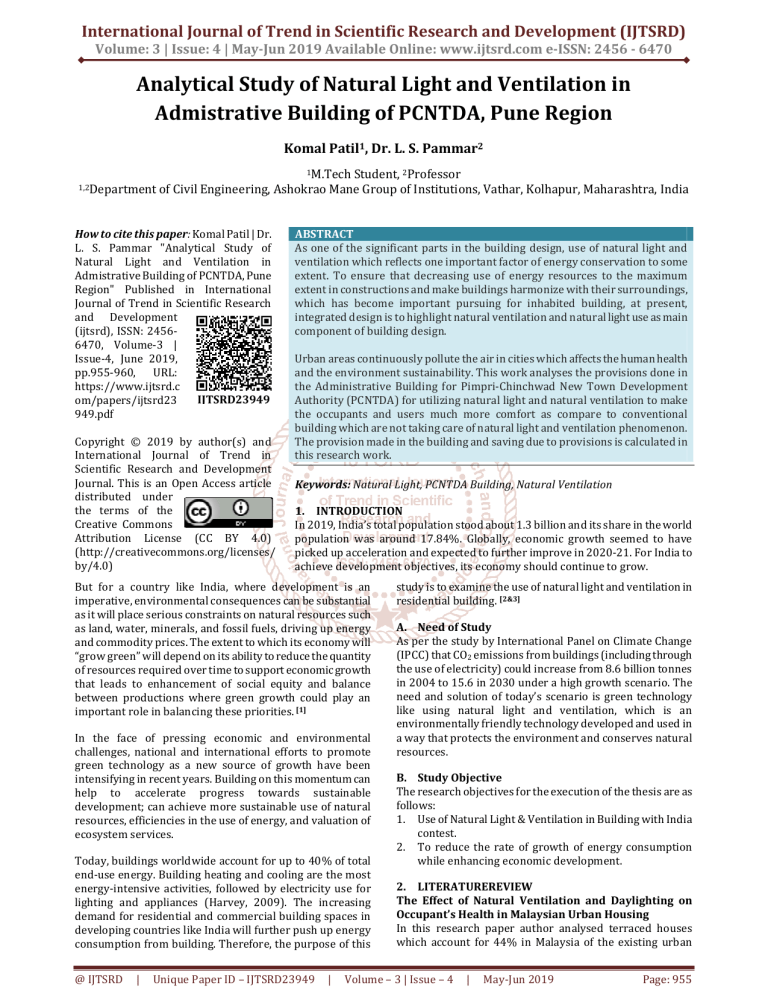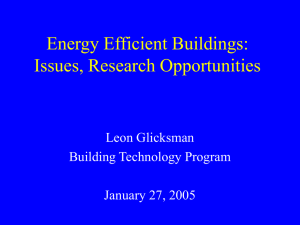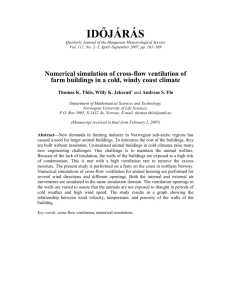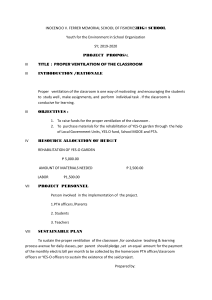
International Journal of Trend in Scientific Research and Development (IJTSRD)
Volume: 3 | Issue: 4 | May-Jun 2019 Available Online: www.ijtsrd.com e-ISSN: 2456 - 6470
Analytical Study of Natural Light and Ventilation in
Admistrative Building of PCNTDA, Pune Region
Komal Patil1, Dr. L. S. Pammar2
1M.Tech
Student, 2Professor
1,2Department of Civil Engineering, Ashokrao Mane Group of Institutions, Vathar, Kolhapur, Maharashtra, India
How to cite this paper: Komal Patil | Dr.
L. S. Pammar "Analytical Study of
Natural Light and Ventilation in
Admistrative Building of PCNTDA, Pune
Region" Published in International
Journal of Trend in Scientific Research
and Development
(ijtsrd), ISSN: 24566470, Volume-3 |
Issue-4, June 2019,
pp.955-960, URL:
https://www.ijtsrd.c
IJTSRD23949
om/papers/ijtsrd23
949.pdf
Copyright © 2019 by author(s) and
International Journal of Trend in
Scientific Research and Development
Journal. This is an Open Access article
distributed under
the terms of the
Creative Commons
Attribution License (CC BY 4.0)
(http://creativecommons.org/licenses/
by/4.0)
ABSTRACT
As one of the significant parts in the building design, use of natural light and
ventilation which reflects one important factor of energy conservation to some
extent. To ensure that decreasing use of energy resources to the maximum
extent in constructions and make buildings harmonize with their surroundings,
which has become important pursuing for inhabited building, at present,
integrated design is to highlight natural ventilation and natural light use as main
component of building design.
Urban areas continuously pollute the air in cities which affects the human health
and the environment sustainability. This work analyses the provisions done in
the Administrative Building for Pimpri-Chinchwad New Town Development
Authority (PCNTDA) for utilizing natural light and natural ventilation to make
the occupants and users much more comfort as compare to conventional
building which are not taking care of natural light and ventilation phenomenon.
The provision made in the building and saving due to provisions is calculated in
this research work.
Keywords: Natural Light, PCNTDA Building, Natural Ventilation
1. INTRODUCTION
In 2019, India’s total population stood about 1.3 billion and its share in the world
population was around 17.84%. Globally, economic growth seemed to have
picked up acceleration and expected to further improve in 2020-21. For India to
achieve development objectives, its economy should continue to grow.
But for a country like India, where development is an
imperative, environmental consequences can be substantial
as it will place serious constraints on natural resources such
as land, water, minerals, and fossil fuels, driving up energy
and commodity prices. The extent to which its economy will
“grow green” will depend on its ability to reduce the quantity
of resources required over time to support economic growth
that leads to enhancement of social equity and balance
between productions where green growth could play an
important role in balancing these priorities. [1]
In the face of pressing economic and environmental
challenges, national and international efforts to promote
green technology as a new source of growth have been
intensifying in recent years. Building on this momentum can
help to accelerate progress towards sustainable
development; can achieve more sustainable use of natural
resources, efficiencies in the use of energy, and valuation of
ecosystem services.
Today, buildings worldwide account for up to 40% of total
end-use energy. Building heating and cooling are the most
energy-intensive activities, followed by electricity use for
lighting and appliances (Harvey, 2009). The increasing
demand for residential and commercial building spaces in
developing countries like India will further push up energy
consumption from building. Therefore, the purpose of this
@ IJTSRD
|
Unique Paper ID – IJTSRD23949
|
study is to examine the use of natural light and ventilation in
residential building. [2&3]
A. Need of Study
As per the study by International Panel on Climate Change
(IPCC) that CO2 emissions from buildings (including through
the use of electricity) could increase from 8.6 billion tonnes
in 2004 to 15.6 in 2030 under a high growth scenario. The
need and solution of today’s scenario is green technology
like using natural light and ventilation, which is an
environmentally friendly technology developed and used in
a way that protects the environment and conserves natural
resources.
B. Study Objective
The research objectives for the execution of the thesis are as
follows:
1. Use of Natural Light & Ventilation in Building with India
contest.
2. To reduce the rate of growth of energy consumption
while enhancing economic development.
2. LITERATUREREVIEW
The Effect of Natural Ventilation and Daylighting on
Occupant’s Health in Malaysian Urban Housing
In this research paper author analysed terraced houses
which account for 44% in Malaysia of the existing urban
Volume – 3 | Issue – 4
|
May-Jun 2019
Page: 955
International Journal of Trend in Scientific Research and Development (IJTSRD) @ www.ijtsrd.com eISSN: 2456-6470
housings. The spatial characteristics of natural ventilation
and daylighting have been studied by author. The analysis
shows the design causes indoor thermal and visual
discomforts due to gloomy indoor spaces, low air change
rate and poor indoor air quality. As per the research paper
indoor environmental stressor can produce negative stress
on occupants’ health, the effect of natural ventilation and
daylighting on occupants’ comfort and health in the terraced
houses was investigated.
envelope have a great influence on daylighting in the internal
area of the building spaces. The amount of opening area, its
orientation, outside obstruction & positioning of building
affects the inside illumination. This paper aims to provide a
simplified analytical and GIS based approach to evaluate the
potential of daylight inside the room under clear sky
conditions. The work evaluates the intensity of internal
illumination in residential apartment building from available
outside external illumination.
The findings demonstrated significant linear relationships
between indoor comfort and health. However, occupant’s
behaviour did not give significant impact on comfort and
health. Besides, the effects of natural ventilation and
daylighting performances on specific health issues were also
studied. The findings concluded that the by-law requirement
of 5% window-to-floor ratio for natural ventilation is
inadequate for occupant’s comfort and health, thus further
review is needed.
Using passive cooling strategies to improve thermal
performance and reduce energy consumption of
residential buildings in U.A.E. buildings
The aim of author for this study is to test the usefulness of
applying selected passive cooling strategies to improve
thermal performance and to reduce energy consumption of
residential buildings in hot arid climate settings, namely
Dubai, United Arab Emirates. One case building was selected
and eight passive cooling strategies were applied. Energy
simulation software – namely IES – was used to assess the
performance of the building. Solar shading performance was
also assessed using Sun Cast Analysis, as a part of the IES
software. Energy reduction was achieved due to both the
harnessing of natural ventilation and the minimising of heat
gain in line with applying good shading devices alongside the
use of double glazing. Additionally, green roofing proved its
potential by acting as effective roof insulation. The study
revealed several significant findings including that the total
annual energy consumption of a residential building in Dubai
may be reduced by up to 23.6% when a building uses passive
cooling strategies.
A Literature Review of the Effects of Natural Light on
Building Occupants
This paper presents summary information from a noncritical
literature review on daylighting in buildings. In this research
paper author compile a listing of the literature that is
commonly cited for showing the impacts of daylighting in
buildings.
According to the Department of Energy’s Office of Building
Technology, State and Community Programs (BTS) 2000
Data book, commercial buildings consumed 32% of United
States electricity in 1998, of which 33% went to lighting. Not
only is electrical lighting responsible for a significant amount
of the electrical load on a commercial building, but it can also
cause excessive cooling loads. Utility costs for a building can
be decreased when daylighting is properly designed to
replace electrical lighting.
Along with the importance of energy, author has
demonstrated the non-energy related benefits of daylighting.
Quantitative studies and qualitative statements are used to
summarize the use of daylighting in buildings, its effects on
occupants, and its potential economic benefits.
Parametric Study of Light-Well Design for Day-Lighting
Analysis under Clear Skies
Author carried out the study of Light wells which are vertical
spaces used in multi-storey buildings to illuminate spaces
without direct day light access. Light wells become an
integral part of the design especially in sites with min
frontage and multi-storey residential buildings. Design
requirement based solely on the dimensions and area
neglects several aspects that may affect the performance of
the light well. Reflectivity, windows area and aspect ratio,
building orientation, and the aspect ratio of the light-well
itself are important factors in determining the performance.
RADIANCE (Radiance is a type of glowing) simulation
models and an automated process using LUA (programming
language) code were used to perform the parametric
variations. A physical building model was used to calibrate
the RADIANCE simulation.
Daylighting estimation and analysis in residential
apartment building: GIS based approach
In this paper author related the opening and light quantum
in building. According to author, the openings in the building
@ IJTSRD
|
Unique Paper ID – IJTSRD23949
|
Natural ventilation in buildings: An overview
According to author, natural ventilation is a sustainable
design strategy. Natural ventilation is of a great
environmental advantage, compared to the mechanical
ventilation strategy. This has encouraged several researches
on natural ventilation implementation in buildings,
considering its main objective of providing buildings with
the required air quality and quantity.
A review of human thermal comfort revealed that natural
ventilation has a high potential for improving thermal
comfort in hot climates, implementing wind-induced
ventilation, and in cold climates, implementing temperatureinduced ventilation. Natural ventilation affects different heat
transfer mechanisms between human body and its ambient
environment. This mostly occurs in the form of sensible heat,
by convection and radiation, and the form of latent heat, by
evaporation of moisture on the skin.
The Effects of Void on Natural Ventilation Performance
in Multi-Storey Housing
It is very crucial to consider the configurations of voids in the
buildings for enhancing natural ventilation, especially for
multi-storey housing. In this study, Malaysian Medium Cost
Multi-Storey Housing (MMCMSH), which is an example of
multi-storey housing located in a suburban area, has been
selected in this study. This study aims to investigate the
potential of void for enhancing natural ventilation
performance in multi-storey housing by the comparison of
two different void configurations. This study revealed that
the provision of void can enhance natural ventilation
performance in multi-storey housing with an increase in the
value of Q, from 3.44% to 40.07%, by enlarging the void’s
width by 50% compared to the existing void.
Volume – 3 | Issue – 4
|
May-Jun 2019
Page: 956
International Journal of Trend in Scientific Research and Development (IJTSRD) @ www.ijtsrd.com eISSN: 2456-6470
Natural Ventilation of Buildings through Light Shafts:
Design-Based Solution Proposals
In this research paper author analyses how the built
environment affects the quality of the air to be introduced
into buildings from light shafts. The main objective of
research by author focuses on the impact of standardized
architecture design in the quality of the indoor air dependent
on the air change in the light shaft. The air change capacity of
the outdoor space is numbered analysed using the concept of
air change efficiency (ACE).
The longer the light shaft in the wind direction is, the better
the ACE is compared with other options. Light shafts up to
12 metres high are the most suitable in order to obtain
acceptable efficiency results. Other studied cases verify that
assumption. Different simplified tools for the technicians to
evaluate the design of buildings containing light shafts are
proposed. Some strategies of architectural design of
buildings with light shafts to be used for ventilation are
presented.
The application of natural ventilation of residential
architecture in the integrated design
According to author, to ensure that decreasing use of energy
resources to the maximum extent in architectures and make
architectures harmonize with their surroundings, which
have become important pursuing gradually for residential
architecture, at present, integrated design of residential
architecture should not only highlight natural ventilation
technique, but also should integrate natural ventilation and
main feature of local climate, etc. What’s more, designers
shall carry out unified analysis on the base of taking all
factors into consideration. This point is more important. By
this way, architecture technique can be more comprehensive
and complete. With the guidance of sustainable development
concept, natural ventilation as one of ecological technologies
is applied extensively in many architecture designs owing to
its economic effect and health benefit.
3. METHODOLOGY
The Primary data will be obtained from the literature review
and case study of building in which natural light and
ventilation is used and applied in basic design of building
and the collected data will be correlated with the present
investigation.
Figure No 1: Overall Methodology Process
@ IJTSRD
|
Unique Paper ID – IJTSRD23949
|
4. CASE STUDY
A. Case Study Brief
Project
Location
Momentary of
Building
Cost
Area
Concern Authority /
Client
Architects and PMC
Electrical
Consultants
Plumbing and
sanitation and firesafety consultants
Environment and
energy audit
Structural
consultants:
Landscape
Architects:
Contractor
Present status
Administrative Building For
Pimpri-Chinchwad New Town
Development Authority
(PCNTDA)
Pune, Maharashtra, India
G+6 green building, five star
rating received from GRIHA
40 Crore
1.4 Lakh Square feet
Pimpri-Chinchwad New Town
Development Authority
Landmark Design Group
Federal Engineering
MCCE
TERI
Gensys technologies
Kshitija Kolhatkar
VMM Infrastructures Pvt Ltd
Work Completed in 30
November 2012 and Building
is in use from February 2013.
B. Case Study Location
Pune also called Poona, the official name until 1978 is the
second largest city in the Indian state of Maharashtra, after
Mumbai. Pune city is known on the world map because of its
scenic beauty and rich natural resources as well as its
educational institutions. Akurdi is a village in India, situated
within Mawal taluka, in Pune district, in the state of
Maharashtra. The latitude and longitude of study area
Administrative Building for PCNTDA is 18°64ʹ94ʺ and 73°76
ʹ89 ʺ.
C. Practice of Sustainability in Building
The case study building is located in Pimpri-Chinchwad, a
twin city of Pune. The Pimpri Chinchwad new Town
Development Authority guides and directs the development
of a sizeable part of this city. The new administrative
building for PCNTDA had of course to be iconic; however, it
ought to make a statement, though in a meaningful sense.
Pune, though classified as part of the humungous ‘warm and
humid zone’ in the ECBC climate map, has a rather moderate
climate, except for the 2.5-3 months of summer. Westerly
wind is actually cool sea breeze from the Arabian Sea that
travels about 100 km inland, having climbed up the steep
Western Ghats, and losing quite a bit of its moisture reroute.
It is well known fact that when it is really warm, air
movement can provide relief and comfort.
The building form was a resultant of the functional
requirements put side by side with solar passive principles.
This involved orienting and locating the various (functional
components) with respect to the sun for thermal comfort,
enhancing this by enabling cross ventilation and maximizing
daylight without ending up with heat gain. Pune being
located at approximately 18.5 degrees north latitude north is
the most appropriate orientation for daylight. So we have
Volume – 3 | Issue – 4
|
May-Jun 2019
Page: 957
International Journal of Trend in Scientific Research and Development (IJTSRD) @ www.ijtsrd.com eISSN: 2456-6470
these two narrow, about 14 metre wide northward, (actually
NNE) facing earth-coloured blocks, that rise up starkly to
nearly 30 metres from the ground, staggered so that daylight
is achieved and views are unhindered. The triangular spaces
in plan house lifts, staircase blocks and toilets. The narrow
easterly and westerly facades are scooped out in the wind
flow direction, the resulting form almost inviting the wind to
flow in. The fenestration is more of a textural treatment, with
shading devices designed appropriate to each orientation.
The east and west walls have large openings, shaded with
horizontal louvers to block direct radiation, but to allow for
free flow of wind across.
Figure No. 2: North orientation for day light
Many small but significant features are incorporated in the
case study building such as perforations in the parapet to
carry away hot air that stagnates at the surface of the roof, or
stack ventilation for the toilet blocks, that prevents odour
spreading to the rest of the building.
Figure No. 4: Evaporative cooling through Westerly
Wind
This has been (amply demonstrated), now that the building
is in use for nearly 7 years now. Since there is very little airconditioning, the energy footprint is so low that the entire
building of nearly 1.4 lakh sqft is run entirely on an online
100 Kw Solar PV system.
Figure No. 3: East west cross ventilation through
louvered openings and Terrace top ventilated to
remove heat
Evaporative cooling is achieved for the canteen area located
above the parking block, by means of westerly wind blowing
over fountains in a waterbody on the terrace garden. The
energy and comfort simulations were carried out by TERI,
and they predicted that just using ceiling fans, the building
would have unsatisfactory comfort conditions for only 4% of
the annual habitable hours.
Figure No. 5: 100 Kw Solar PV system
A light shelf is a horizontal surface that reflects daylight deep
into a building. Light shelves are placed above eye-level and
have high-reflectance upper surfaces, which reflect daylight
onto the ceiling and deeper into the space.
Light shelves are typically used in high-rise and low-rise
office buildings, as well as institutional buildings. This design
@ IJTSRD
|
Unique Paper ID – IJTSRD23949
|
Volume – 3 | Issue – 4
|
May-Jun 2019
Page: 958
International Journal of Trend in Scientific Research and Development (IJTSRD) @ www.ijtsrd.com eISSN: 2456-6470
is generally used on the equator-facing side of the building,
which is where maximum sunlight is found, and as a result is
most effective. Not only do light shelves allow light to
penetrate through the building, they are also designed to
shade near the windows, due to the overhang of the shelf,
and help reduce window glare. Exterior shelves are generally
more effective shading devices than interior shelves. A
combination of exterior and interior shelves will work best
in providing an even illumination gradient.
Architectural light shelves have been proven to reduce the
need for artificial lighting in the case study buildings.
Design Used in Case Study Building:
Carpet area to be air-conditioned
Installed capacity of air-conditioning
Average power consumed in 8 hr cycle
No. of ceiling fans
Avg no. of hours of ceiling fan use
Average power consumption per fan (in
8 hr Cycle)
=11237 sft
= 82TR
= 82X1.2X8 hrs
=787.20 units
=180 no.s
= 6 hrs per day
= 0.5 units
Total power consumption by ceiling fans per day =90 units
Total power consumption for air conditioning and ceiling fan
combination
= 877.2 units
Net power consumption for 270 working days
=236844 units
Net savings in unit terms per year
=955476 units
Present cost per unit (commercial)
=Rs 5.50
Net savings per year in Rupees due to maximization of
natural ventilation
=Rs55,55,118.00
Day Light
ii.
Conventional building:
No.of
fittings
(3
X
36w
CFL
tube
600mmX600mm)required =1200 no.s
Average power consumption per fitting per day (8 hrs) =
0.9 units
Total no. of working days in a year = 270 days
Total no. of overcast days = 80 days
Total no. of clear days = 190 days
No. of fittings in use in a conventional building on
A clear day (considering 15% daylighting) = 85% i.e.
1020 fittings
Power consumption for 190 days = 174420 units
No. of fittings in use in a conventional building on
overcast day
(considering 0% daylighting) = 100% i.e. 1200 fittings
Power consumption for 80 days = 86400 units
Total annual power consumption for lighting = 2, 60,820
Units
Figure No. 6: Light shelf for enhancing daylight
D. Design Calculation
Simple calculations as illustrated in the following section
helped to understand the ‘naturally ventilated and day light’
building was the right choice and much better saving other
than conventional buildings.
i.
Air Conditioning
In a conventional office building 100% carpet area is covered
by air-conditioning.
Conventional building:
Carpet area to be air-conditioned
Required capacity of Air-conditioning
Average power consumed in 8 hr cycle
(Mean of summer, monsoon and winter
=63072 Sq. ft
=460 TR
=460X1.2X8 hrs
=4416 units
Cooling load)
Net power consumption for 270 working days
=11, 92,320 units
@ IJTSRD
|
Unique Paper ID – IJTSRD23949
|
Design Used in Case Study Building:
No. of fittings (3 X 36 w CFL tube 600mmX600mm) required
=1200 no.s
Average power consumption per fitting per day (8 hrs) =
0.9 units
Total no. of working days in a year = 270 days
Total no. of overcast days = 80 days
Total no. of clear days = 190 days
No. of fittings in use in our building on clear day
(considering 90% daylighting) = 10% i.e. 120 fittings
Power consumption for 190 days = 20520 units
No. of fittings in use in our building on overcast day
(considering 0% daylighting) = 100% i.e 1200 fittings
Power consumption for 80 days = 86400 units
Total annual power consumption for lighting =106920
units
Net savings in unit terms per year = 153900 units
Present cost per unit (commercial) = Rs 5.50
Net savings per year in Rupees due to maximization of
Daylighting = Rs 8, 46,450.00
Volume – 3 | Issue – 4
|
May-Jun 2019
Page: 959
International Journal of Trend in Scientific Research and Development (IJTSRD) @ www.ijtsrd.com eISSN: 2456-6470
5. CONCLUSION
The learning outcome from the comprehensive study of
Administrative Building for PCNTDA is that the building is
designed and executed to make a strong pro-environment
statement by making a model green building. Considering
the almost moderate climate of the Pune city with only four
months of extreme weather in the summer, effort was made
to maximize naturally cooled spaces and minimize artificially
conditioned spaces. Building orientation was important, with
maximum length of the building façade towards north and
south. The maximum glazing was provided on the north to
make best use of the diffused natural light. A combination of
horizontal and vertical shading devices were used cut down
direct solar gain. Light shelves for deeper daylight
penetration, evaporative cooling with the help of
strategically placed water bodies and ventilated under
surface of roof to disseminate heat are few other methods
adopted to reduce energy consumption. With these
initiatives, artificial conditioning is only used in 11,237 sqft
of the building's carpeted area (out of a total 63,072sqft)
which lead to the annual saving of 55.5 lakh per year in air
conditioning.
[3] H. Kotani, M. Narasaki, R. Sato, and T. Yamanaka,
“Environmental assessment of light well in high-rise
apartment building,” Building and Environment, vol.
38, no. 2, pp. 283–289, 2003.
It is also observed that GRIHA was used as a guiding tool in
the entire design and construction process to achieve the
desired target. Since 1% renewable energy integration is
mandatory in GRIHA, the project opted for solar
photovoltaic. Eventually, with additional 30% subsidy on
solar panels by MNRE, the project installed solar
photovoltaic of 100kWp capacity that would generate energy
equivalent to the consumption of the entire building which
will again save the money.
[9] C. F. Reinhart and M. Andersen, “Development and
validation of a Radiance model for a translucent panel,”
Energy and Buildings, vol. 38, no. 7, pp. 890-904, 2006.
REFERENCES
[1] Egyptian Ministry of Housing, Utilities, and the Urban
Development, Central Agency For Public Mobilization &
Statistics Data Cairo, Kasr El Ainy, Cairo, Egypt.
[4] Z. Kristl and A. Krainer, “Light wells in residential
building as a complementary daylight source,” Solar
Energy, vol. 65, no. 3, pp. 197–206, 1999.
[5] N. Lechner, Heating Cooling, Lighting, 2nd ed. Wiley:
New York, 2001, pp. 368–369.
[6] Y.-H. Su et al., “Evaluation of a lightwell design for
multi-storey buildings,” International Journal of Energy
Research, Int. J. Energy Res. (2010), Wiley Inter Science
Published Online: 14, Jan 2010.
[7] I. Diego et al., “Daylight factor simulations – how close
do simulation beginners „really‟ get?” in Proc. Eleventh
International IBPSA Confe. Glasgow, Scotland, July 2730, 2009.
[8] J. Mardaljevic, “Simulation of annual daylighting
profiles for internal illuminance,” Lighting Research &
Technology, vol. 32, no. 2, pp. 111-118, 2000.
[10] C. F. Reinhart and O. Walkenhorst, “Dynamic
RADIANCE-based daylight simulations for a full-scale
test office with outer venetian blinds,” Energy &
Buildings, vol. 33, no. 7, pp. 683-697, 2001.
[11] Hopkinson R G, Petherbridge P and Longmore J 1966
Daylighting, Heinemann, London
[12] Harvey J Bryan 1979 A simplified procedure for
calculating the effects of daylight from clear skies
Lawrence Berkeley Laboratory, University of California
Berkeley, California
[2] M. D. Egan and V. W. Olgyay, Architectural Lighting,
2nd ed. McGraw-Hill: New York, 2002, pp. 27–30.
@ IJTSRD
|
Unique Paper ID – IJTSRD23949
|
Volume – 3 | Issue – 4
|
May-Jun 2019
Page: 960






